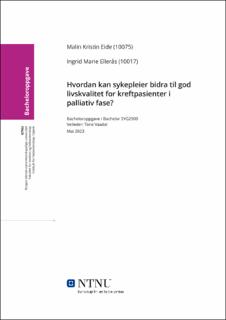| dc.contributor.advisor | Vaadal, Tone | |
| dc.contributor.author | Eide, Malin Kristin | |
| dc.contributor.author | Ellerås, Ingrid Marie | |
| dc.date.accessioned | 2023-07-15T17:19:47Z | |
| dc.date.available | 2023-07-15T17:19:47Z | |
| dc.date.issued | 2023 | |
| dc.identifier | no.ntnu:inspera:139585348:151284328 | |
| dc.identifier.uri | https://hdl.handle.net/11250/3079362 | |
| dc.description.abstract | Bakgrunn: Kreft er en av de mest dødelige sykdommene på verdensbasis. I takt med økt befolkning og økt levetid er det forventet at antallet mennesker som får en kreftdiagnose vil øke. Sykepleiere vil kunne møte flere palliative kreftpasienter i fremtiden, hvor best mulig livskvalitet står i fokus.
Hensikt: Å belyse hvilke tiltak sykepleier kan gjøre for å bidra til god livskvalitet for kreftpasienter i palliativ fase.
Problemstilling: Hvordan kan sykepleier bidra til god livskvalitet for kreftpasienter i palliativ fase?
Metode: Denne oppgaven har litteraturstudie som metode. Oppgaven tar for seg 7 forskningsartikler, funnet etter systematiserte søk i Pubmed og Cinahl.
Resultat: Vår analyseprosess avdekket tre viktige tiltak som omhandlet “systematisk kartlegging”, “kommunikasjon og relasjonens betydning” og “sykepleiers pedagogiske funksjon”.
Konklusjon: Grundig, rutinemessig kartlegging av pasientens symptomer er viktig for å kunne sette inn riktig tiltak. Gode kommunikasjonsferdigheter er viktig for å skape en god relasjon med pasienten, slik at de kan åpne seg om sine tanker og plager. Samtidig må pasienten få grundig og tilpasset informasjon om sin helsetilstand. Alle tiltakene bør settes i gang så tidlig som mulig, og kontinuerlig følge pasienten gjennom hele forløpet. For å best mulig gjennomføre alle tiltakene er en god relasjon med pasienten noe av det viktigste, og kan bidra til å lindre deres symptomer. Dette vil bidra til å øke pasientens livskvalitet over tid. | |
| dc.description.abstract | Background:
Cancer is one of the deadliest diseases worldwide. In line with increased population and increased life expectancy, it is expected that the number of people receiving a cancer diagnosis also will increase. As a result, there is a possibility that nurses will treat more palliative cancer patients and with a focus on best possible quality of life.
Purpose:
To shed light on what measure nurses can take to contribute to a god quality of life in palliative cancer patients.
Issue:
How can nurses contribute to an increased quality of life in cancer patients in the palliative phase?
Method:
This thesis has a literature study as it method. The assignment addresses seven research articles, found by systematic searches in Pubmed and Cinahl.
Results:
Our analysis process revealed thee important interventions witch dealt with “systematic mapping”, “communication and the importance of relationship” and “nurses’ pedagogical function”.
Conclusion:
Thorough, routine mapping of the patient’s symptoms is important to be able to implement the right intervention. Good communication skills are important to create a good relationship with the patient, in order for them to be open about their thoughts and complaints. At the same time, the patient must receive thorough and adapted information about their state of health. All inventions should be started as early as possible, and the patient should be continuously followed up. In order to carry out all the intervention as best as possible, a good relationship with the patient is one of the most important things in alleviating their symptoms. This will help to increase the patient’s quality of life over time. | |
| dc.language | nob | |
| dc.publisher | NTNU | |
| dc.title | Hvordan kan sykepleie bidra til økt livskvalitet for kreftpasienter i palliativ fase? | |
| dc.type | Bachelor thesis | |
